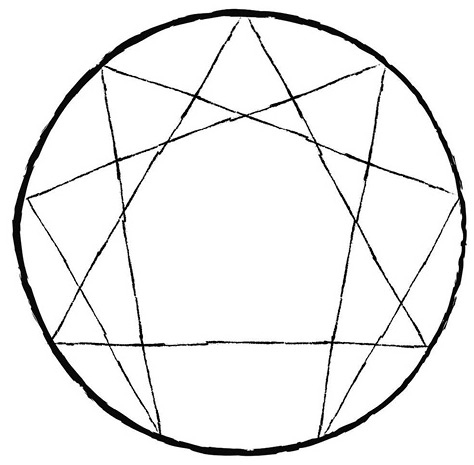
The Enneagram is a powerful tool for self-improvement, based on eternal wisdom that guides people to the realization of their true individuality. It will help you get rid of defense mechanisms and self-limiting patterns of thinking, free yourself and grow. What is an enneagram?
The Enneagram is a complex and multifaceted symbol that relates to various systems of knowledge, including psychology, cosmology, and mathematics. It is the basis of a highly accurate typology that clearly describes nine personality types and serves as a semantic base for understanding the human ego and planning for further growth. As a psychological and spiritual model of ways of self-development, the enneagram helps to "wake up" and see the real self through the eradication of habits and blind spots that prevent growth and transformation.
The Enneagram includes nine personality types enclosed in three "cognitive centers" that determine our style of receiving and processing information from the outside world. • We think and analyze with the center of the head. It dominates in types 5, 6 and 7, their experience is formed by thoughts. They have an analytical mindset and a developed imagination, they know how to plan and understand what is happening, but they tend to be overly guided by logic and abstract from feelings and emotions.
• We experience emotions and connect with others through the center of the heart. It dominates in types 2, 3 and 4, their experience is formed due to sensory experiences. Typically, these types of people have developed emotional intelligence and empathy, value communication and relationships, but tend to focus too much on the image and fear rejection. • We experience life through the sense organs and the center of the body. It dominates in types 1, 8 and 9, their experience is formed by sensations. These types are usually loyal, responsible people who value truth and honesty, but can criticize and do not like to give in.
We lose balance when we use one of the centers more than the other two. The Enneagram helps you recognize imbalances and correct them.
Each of the nine types on the enneagram circle can be identified by a property of a basic coping strategy, made up of patterns of behavior and motivations. We unconsciously develop strategies to avoid pain and discomfort in the outside world. If we perceive ourselves as the sum of all unconscious patterns, then we lose sight of our true individuality and understanding of our capabilities. The fact that these strategies are stored at the unconscious level makes it even more difficult (or impossible) to understand and overcome them. But in fact, we are much more than we think, and the enneagram helps to realize this.
Each of the nine personality types on the enneagram circle has three subtypes, for a total of 27 personality types. These subtypes are more detailed versions of the original nine types and are defined by three instinctive drives (needs): self-preservation, social belonging, and sexual fusion. Each subtype demonstrates how instincts shape behavior and express our deepest emotional motivations. In personality types, these three subtypes differ in special shades, and among them there is one countertype, which in a sense goes against the general manifestation of personality, since emotional attraction and instinctive goal move in opposite directions.
To experience amazing moments of awareness with the enneagram, you must first determine which type best matches your personality and find the subtype that best describes you. Not an easy task, because different types seem similar, and it is possible that you will identify with more than one of them. The fact that descriptions of types refer in part to unconscious habits, or blind spots, further complicates the task.
On the one hand, these personality types are based on a fairly simple idea: we pay attention to certain things more often when living in the outside world. At the same time, what we see also determines what we do not see, and all this happens involuntarily. These are our blind spots. If we are not aware of the key aspects of our experience, then we remain blind to their influence on our thinking, feelings and actions. That is why such a state can be described as a dream - living in zombie mode.
In order to wake up and get out of this state, we must overcome the ego, as well as the shadow that it casts. We must become aware of the automatic habits that form the protective selfish personality and all the unconsciousness associated with the ego's need to protect itself. A self-protective personality forces us to focus on its needs and does not allow us to experience pain (or joy), forcing us to live in a half-sleep. We do not understand who we really are and what opportunities are open to us. We suppress shadow particles because they cause pain and challenge our self-image. With a mindful approach, we begin to understand ourselves more deeply and restore integrity. Without looking into the face of these elements, we will not know our true self. Unconscious tendencies limit us, and if we do not notice them, then we become hostages of our own ideas, fears about what might happen to us, or fantasies about who we could be. When we transcend selfish boundaries and actively engage in the developmental process offered by the enneagram, we awaken and reach our full potential.
Congratulations @foarsyad! You have completed the following achievement on the Hive blockchain And have been rewarded with New badge(s)
Your next target is to reach 7000 upvotes.
You can view your badges on your board and compare yourself to others in the Ranking
If you no longer want to receive notifications, reply to this comment with the word
STOPCheck out our last posts: